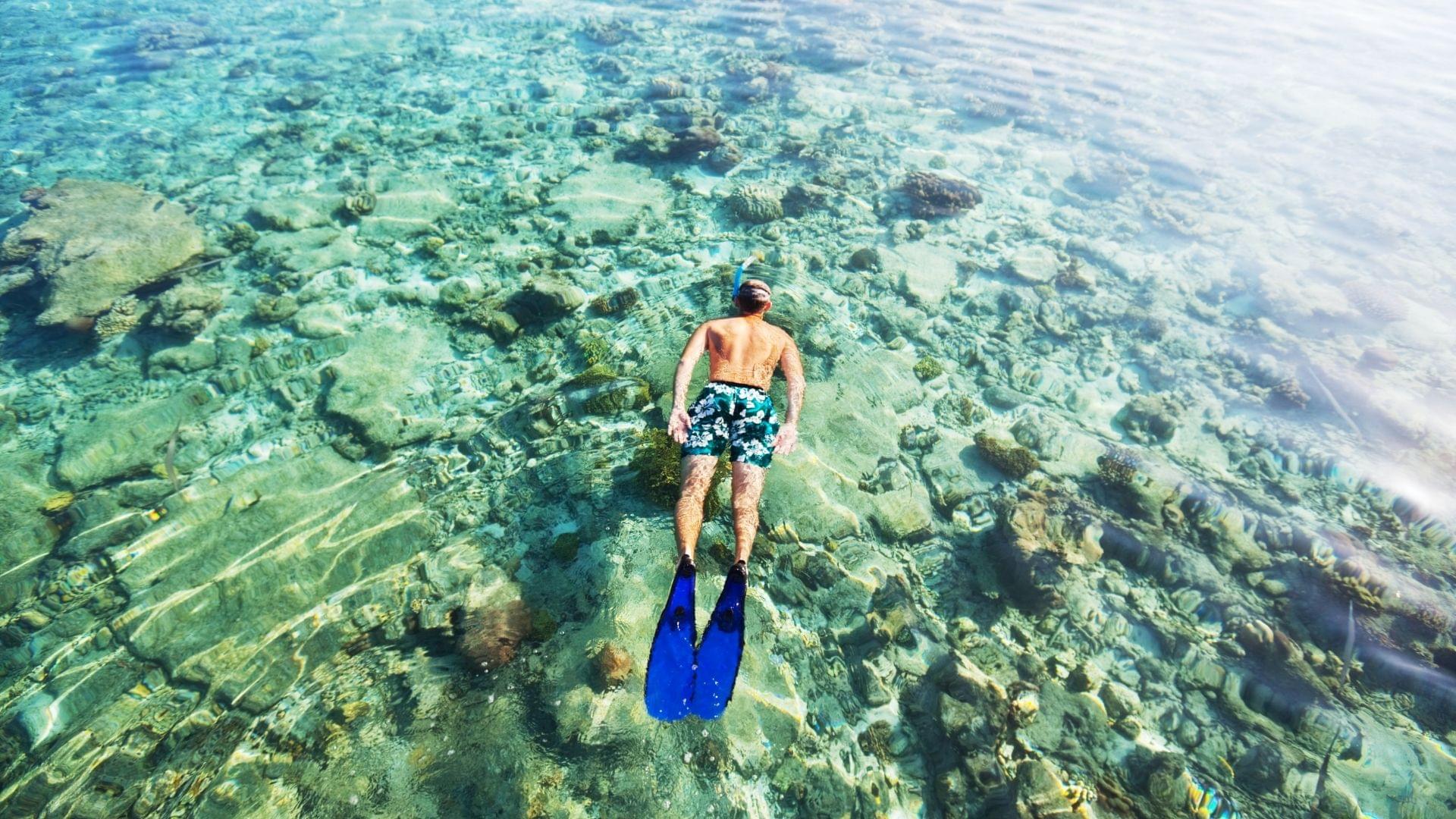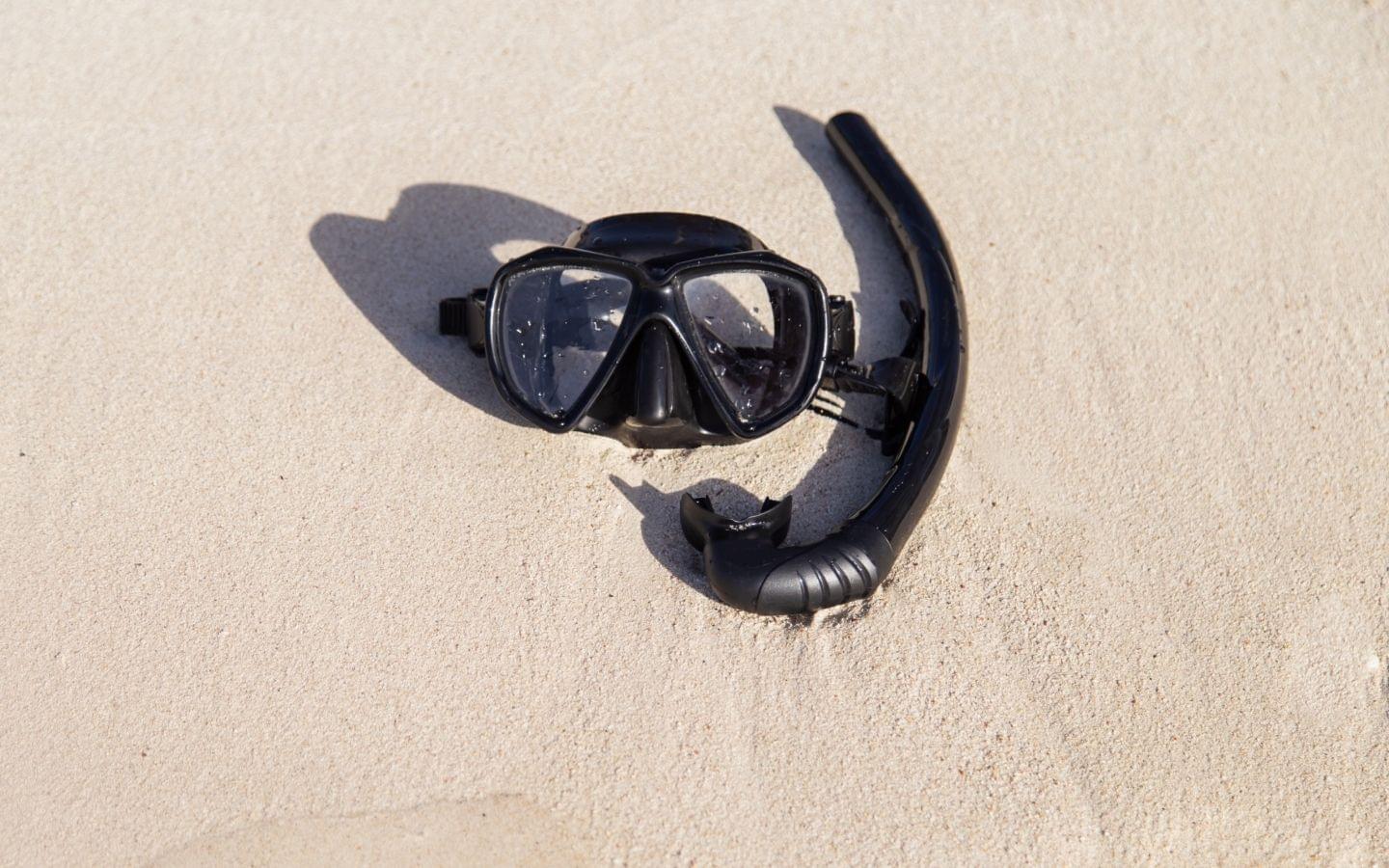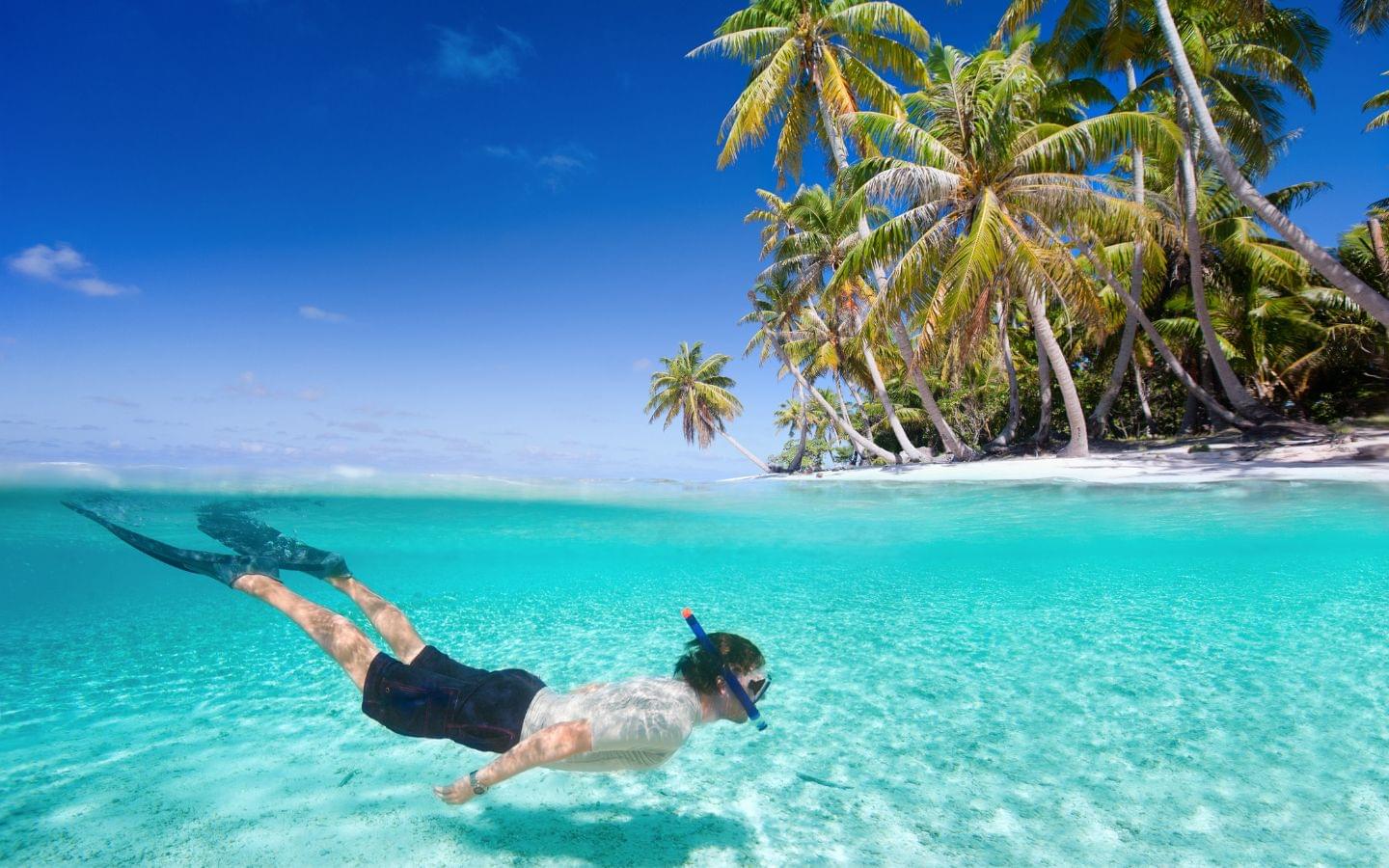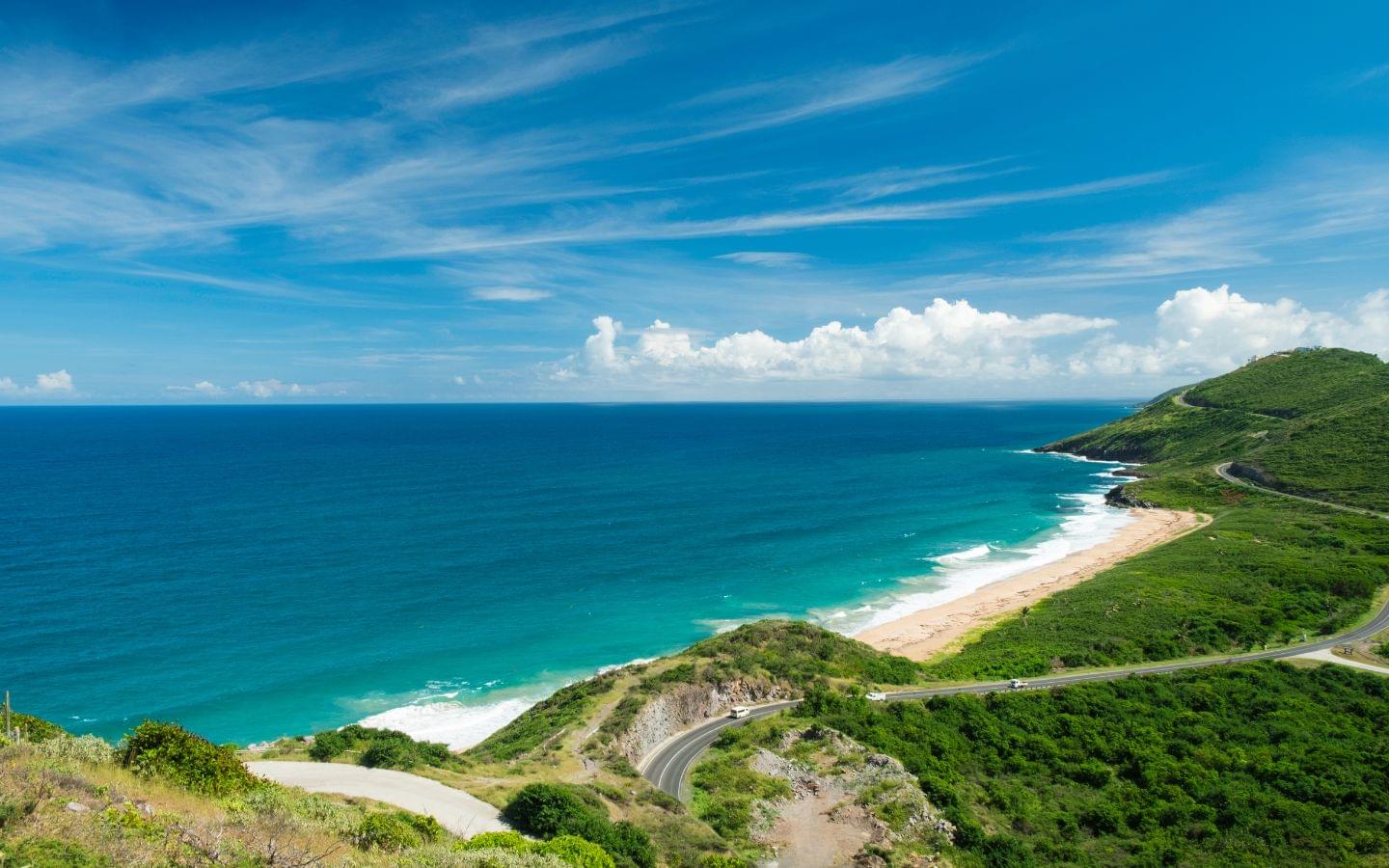Snorkeling 101: How does snorkeling work?
Have you ever seen people snorkeling and wondered how snorkeling works? Find the answers you need here and get ready for your own snorkeling adventures!
Snorkeling is a popular watersport that can make an exciting addition to your vacation or a fun new hobby. If you’ve never tried it, you may have questions that need answering before diving into the water with your snorkeling gear.
One of the most common questions among first-time snorkelers is, ‘how does snorkeling work?’
Snorkelers use equipment, including a mask and snorkel, that allows them to view the underwater world while floating at the surface and breathing through a snorkel tube. The top of the tube must stick out above the water’s surface for air exchange to occur.
This beginner’s guide will cover all the essential information you need to start snorkeling. After reading the article, you should understand how snorkels work and how to use different types of snorkels safely. You’ll also learn what equipment and skills snorkeling requires, what places are best for snorkeling, what you can see under the surface, and basic safety and etiquette guidelines.
Armed with this information, you’ll be snorkeling confidently in no time.
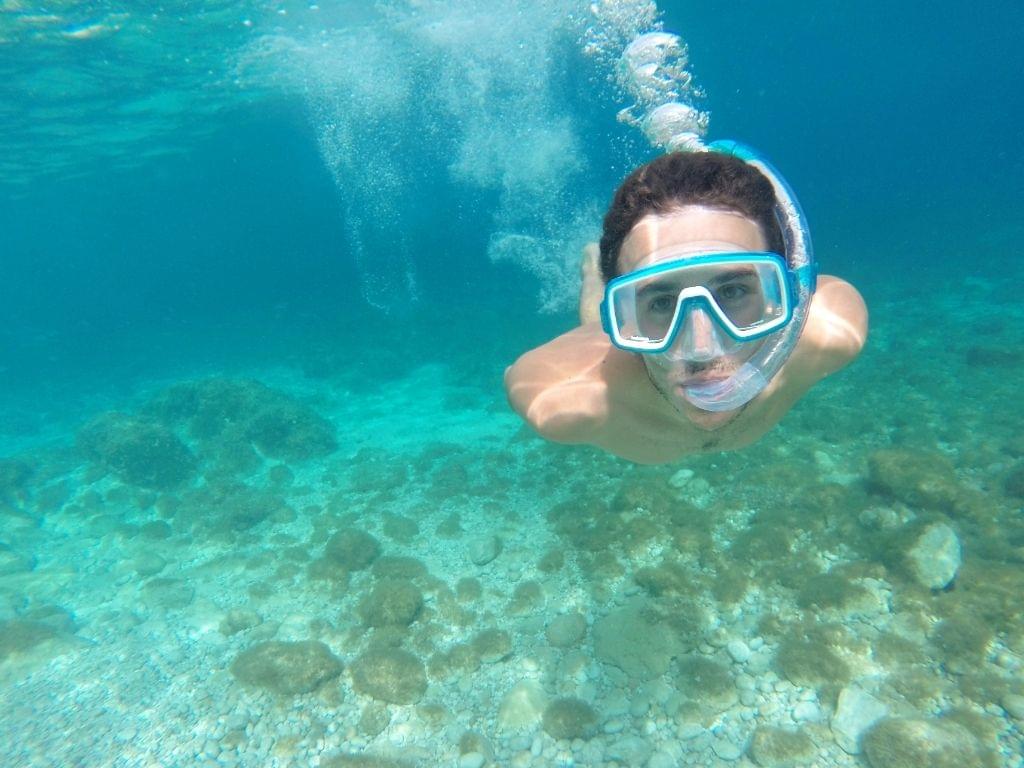
How does a snorkel work?
A snorkel allows you to breathe through your mouth while your face is submerged near the water’s surface. The equipment is designed to provide a comfortable experience and effective gas exchange between your lungs and the air above the waterline.
Classic snorkels consist of only a tube, mask clip, and mouthpiece, while more modern types of snorkels have added features for enhanced comfort and ease of use. These could include things like:
- A flexible tube, or flex tube, toward the bottom of the snorkel, which provides a more comfortable fit and reduces jaw fatigue.
- A splash guard at the top of the snorkel to keep water from splashing swimmers and waves out of the tube.
- A purge valve at the bottom of the snorkel, which allows water to drain more easily if it does happen to enter the tube.
- A float valve to prevent water from filling the tube when the snorkel is submerged.
Can you breathe underwater with a snorkel?
Unlike scuba diving equipment, snorkels do not allow you to breathe deep underwater. Instead, snorkelers must exchange air at the surface of the water through the breathing tube. If the snorkel is submerged beneath the waterline, the snorkeler will not be able to breathe through the tube.
How to use a mask and snorkel
Breathing through a snorkel can take some getting used to, but with a little practice, you’ll be able to snorkel with ease. Follow the steps below and practice in shallow water near shore or in a swimming pool before heading into deeper areas.
- Make sure your mask fits snugly and seals properly to help prevent fogging.
- Securely attach the snorkel to the mask using the snorkel keeper, mask clip, or other attachment, and adjust it as needed for a comfortable fit.
- Place the mouthpiece in your mouth and bite it gently. Your lips should hold it in place and seal around it.
- Put your face in the water, make sure to keep the top of the tube above the waterline, and breathe in through your mouth.
- Take slow, deep breaths to conserve energy and ensure proper air exchange.
- Once you feel comfortable, you can try swimming around and continuing to breathe deeply.
- It’s not unusual for snorkelers to end up with a mouth full of water, especially at first. If any water enters the tube, don’t panic. You can clear the tube by exhaling sharply to force the water out or by removing the mouthpiece from your lips, spitting out the water, and allowing any remaining water in the tube to drain out.
Check out our article about how to snorkel without swallowing water for more tips.
Types of snorkels
If you’re unfamiliar with snorkeling gear, snorkels may all look relatively similar. However, several key differences between the various types of snorkels make some better suited to particular skill levels, conditions, and activities than others.
There are three main types of snorkels:
- Semi-dry
- Dry
- Wet
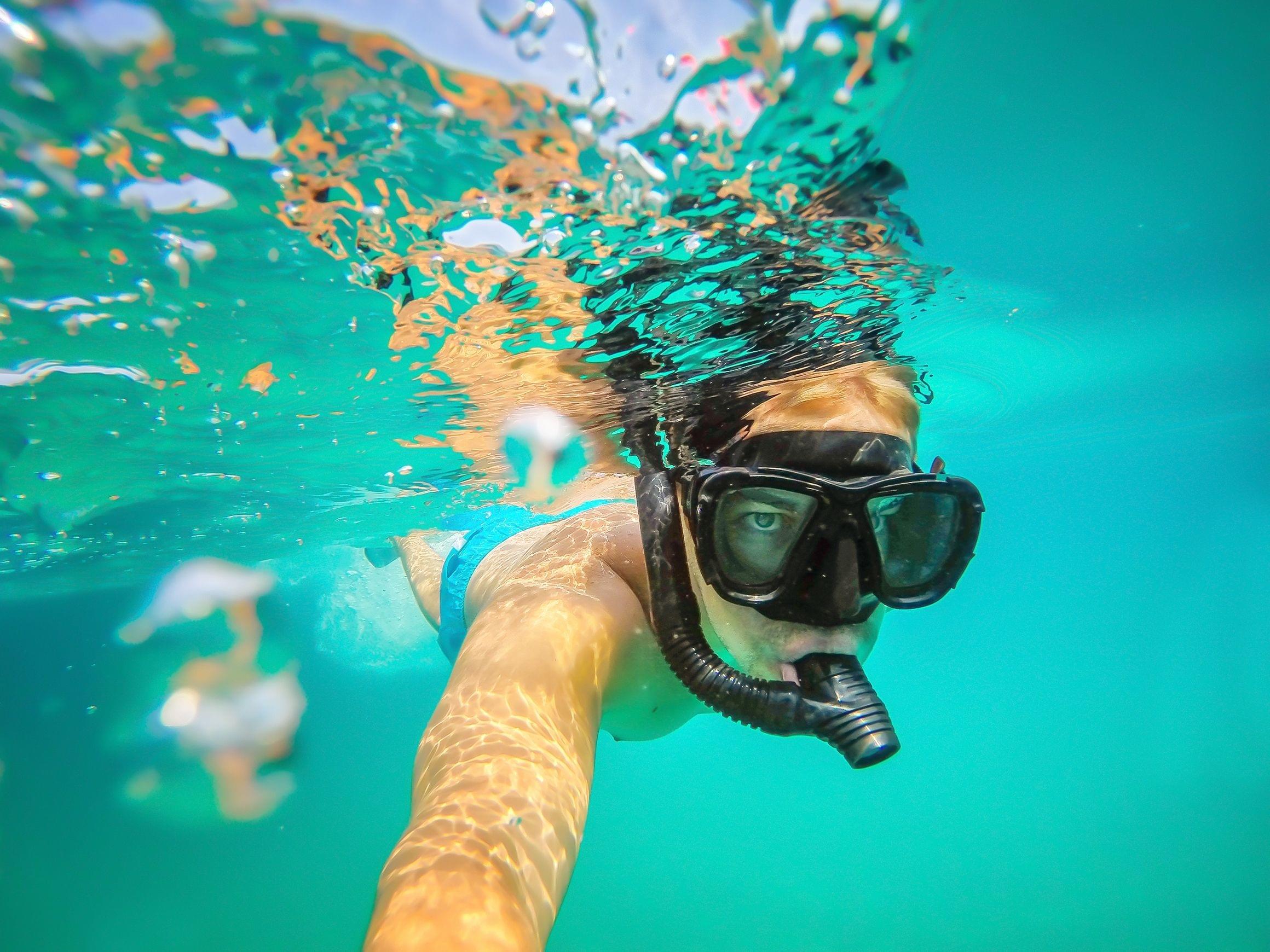
Semi-dry snorkels
Semi-dry snorkels are the most versatile of all snorkel types and strike a good balance between function and comfort. The top of the tube includes a splash guard to keep water out when snorkeling at the surface, which could occur due to splashing waves or nearby swimmers.
The snorkels also include a purge valve at the bottom, allowing snorkelers to clear any water that does get into the tube.
Since semi-dry snorkels do not prevent water from entering the tube when submerged, they’re not the best choice for beginners. Semi-dry snorkels are better for snorkelers who have some prior experience and plan on diving underwater. This type of snorkel is also a common choice among scuba divers, as well as some spearfishers and freedivers.
Dry snorkels
Dry or dry-top snorkels typically have the same features as semi-dry snorkels, with the addition of a float valve. This mechanism seals the tube and prevents water from getting inside when the snorkel is completely submerged, which could occur if the snorkeler dives underwater or is snorkeling in wavy conditions.
As the only type of snorkel that keeps water out of the breathing tube when submerged, dry snorkels are the best option for beginners. However, this feature also traps air inside the tube and creates unwanted drag and buoyancy underwater. As a result, dry snorkels are not well-suited for activities like freediving, spearfishing, and scuba diving since the wearer spends a lot of time under the surface.
Dry snorkels are available in a classic tube shape with a separate mask or as a full-face snorkel mask. You can learn more about dry snorkels and how they work here.
Wet snorkels
Wet snorkels, also known as J-tube snorkels or J-style snorkels, are the most basic of the three types. These traditional snorkels do not usually include specialized features that keep water out of the tube or make it easier for water to drain. As a result, wet snorkels are not a good choice for beginners.
Many freedivers and spearfishers, as well as some experienced snorkelers, prefer this type of snorkel because of its simple design and minimal drag underwater.
Additional snorkeling equipment
The mask and snorkel are the two most crucial pieces of snorkeling gear, but there are a few other items that you may require, including fins, a snorkel vest, a swim buoy or dive flag, and a wetsuit. We’ll describe each of these pieces of equipment below, but for a full list of what to wear snorkeling and additional tips, you can view our guide here.
Fins and fin socks
Fins are not essential for snorkeling, but they allow snorkelers to move through the water with less effort. As a result, fins are very useful for beginners and can help you snorkel for longer without feeling fatigued. Fins are often sold together with a mask and snorkel, making it simple to get these three pieces of equipment in a single, beginner-friendly gear bundle.
To make the fins more comfortable and reduce your chances of getting blisters, we recommend wearing fin socks with your flippers.
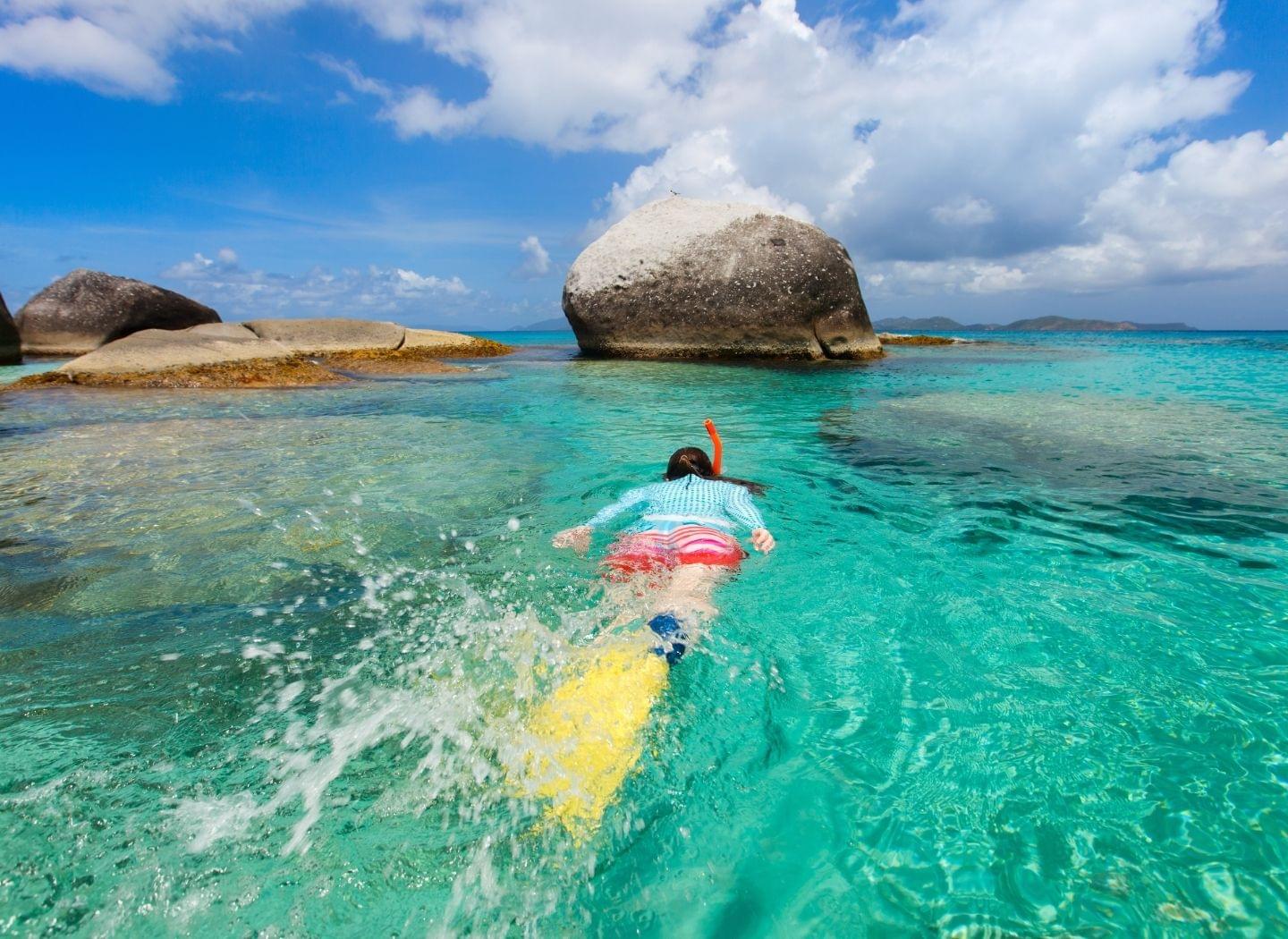
Snorkel vest
Unlike life jackets and many other personal flotation devices, snorkel vests keep the wearer afloat while still allowing them to swim easily with their face submerged.
Anyone who is not a confident swimmer should always wear a snorkel vest while snorkeling (see which snorkel vests we recommend here). While this piece of equipment is not typically required for strong swimmers, it can make the snorkeling experience safer, more comfortable, and more relaxing.
Wearing a snorkeling vest makes it much easier for first-time or inexperienced snorkelers to maintain correct body positioning on the water’s surface so that they can relax and enjoy themselves.
Snorkel vests also improve safety in emergencies or unforeseen conditions, such as a jellyfish sting, medical issue, sudden waves, or strong current, and increase visibility.
Some areas, like national parks or marine reserves, require all snorkelers to wear a snorkeling vest regardless of swimming ability. Many snorkeling tours also require participants to wear a vest for added safety.
To learn more about why snorkel vests are the best flotation device for snorkelers, read our in-depth article.
Swim buoy or dive flag
Wearing a swim buoy with an attached dive flag helps protect you from boat traffic while snorkeling. In some areas, including Hawaii, this is even required by law.1
These flags and brightly colored floats alert watercraft that there is a swimmer, snorkeler, or diver in the water and that vessel operators should avoid coming too close. As a result, the flags and buoys reduce the risk of an accident.
Dive flags and inflatable floats come in various sizes for different use cases. The best types for snorkeling are compact and come with a rope or strap so you can attach the float to your waist (see an example here).
Once attached, the float will follow you as you swim through the water. When you’re done, you can deflate the float, fold it up, and easily store it with the rest of your snorkeling gear.
No matter what you’re wearing, you should always remain aware of your surroundings and stay in designated snorkeling and swimming areas where marked.
Wetsuit
Wetsuits come in all different shapes and sizes, providing varying levels of thermal insulation. In addition to keeping you warm, a wetsuit can also help protect you from the sun, jellyfish stings, abrasions, and other irritants in the water.
Whether or not you require a wetsuit for snorkeling will mostly depend on the water temperature at your destination. If you plan on snorkeling in a tropical area, it’s unlikely you’ll need to wear a wetsuit for shorter snorkeling sessions. In cooler waters, a wetsuit is essential to remain safe and comfortable while snorkeling.
Skills required for snorkeling
Snorkeling is a very accessible water sport that doesn’t require any advanced skills. However, practicing and mastering the techniques below can improve your experience.
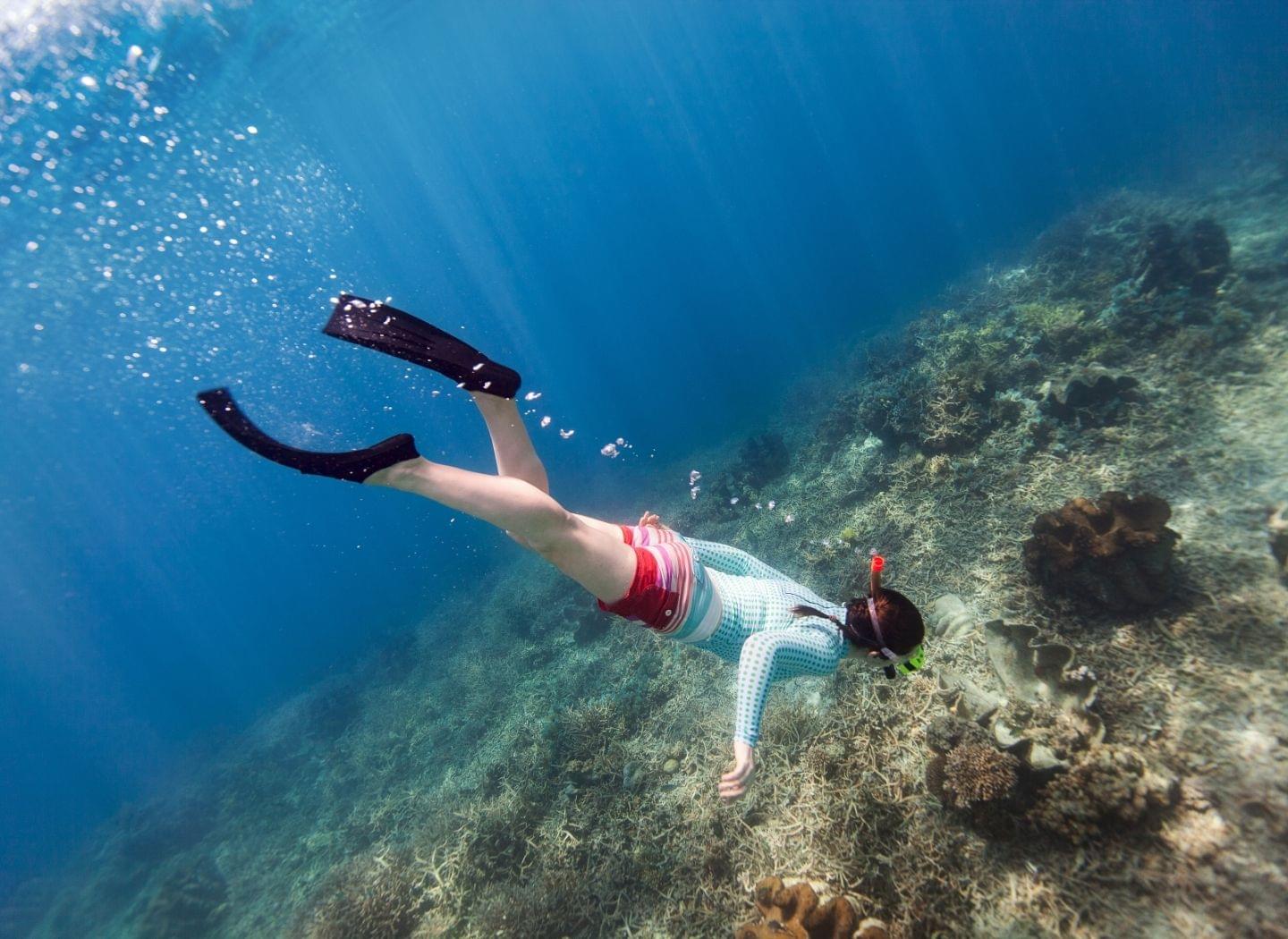
Swimming
While non-swimmers can go snorkeling, knowing how to swim will increase your safety and enjoyment. If you’re planning a snorkeling trip and are not a confident swimmer, you may find it beneficial to take swimming lessons ahead of time.
You’ll want to pay extra attention to your kick. Pushing yourself through the water with only your legs and fins while keeping your arms relaxed at your sides will help you conserve energy. Make sure to minimize splashing to avoid scaring away the fish.
Deep breathing
Proper breathing techniques while snorkeling will help you stay relaxed, keep you safe, and prevent dizziness. When you breathe through a snorkel, your lungs have to work harder to overcome the additional respiratory dead space.2 Each time you exhale, some of the air remains in the tube and is inhaled again, which can cause carbon dioxide to build up in the blood.
When employed properly, deep breathing techniques can help prevent this from occurring by exchanging the air in the snorkel tube more efficiently. Before you get in the water, familiarize yourself with deep breathing and diaphragmatic breathing exercises. Practice inhaling and exhaling slowly and deeply so that it comes naturally to you when you’re breathing through a snorkel.
Conserving energy
Poor technique and overexertion can quickly tire you out in the water, making snorkeling less enjoyable. Try to stay relaxed and focus on floating comfortably at the surface while looking down and slightly forward.
Employ the deep breathing and swimming techniques outlined above, focusing on kicking gently with your feet or fins while keeping your arms relaxed at your sides. We recommend using a snorkel vest or other buoyancy aid at first to help you stay afloat with minimal effort.
It’s good to keep your snorkeling sessions short at first and take a break if you feel tired. You can remove the snorkel tube from your mouth and float in the water, or head to shore, relax on the beach, and then go back for another round of snorkeling. Don’t forget to hydrate and have a light snack to refuel.
Breath-hold diving
Advanced snorkelers and freedivers hold their breath as they swim and explore under the surface, a skill known as breath-hold diving. Learning this technique and increasing the amount of time you can hold your breath will allow you to immerse yourself deeper in the underwater world and get closer to coral reefs and other marine life.
Make sure to avoid hyperventilating before diving since this can have harmful effects.3
What is there to look at when snorkeling?
One of the most exciting things to see while snorkeling is aquatic life. The types of creatures you can see vary from one location to the next. Top snorkeling sites typically offer the chance to spot marine life like colorful fish, sea turtles, rays, crustaceans, mollusks, coral formations, sea fans, and more. In certain locations, larger sea life like whales, sharks, dolphins, mantas, and sea lions may also make an appearance.
Besides wildlife, snorkeling sites may also offer other exciting things to view underwater. Some locations have unique rock formations or underwater caves, while other areas are home to shallow shipwrecks, ancient ruins, or artificial sculptures.
In certain places, you can even see underwater geothermal activity. Champagne Reef on the Caribbean island of Dominica, for example, makes snorkelers feel like they are swimming in a champagne glass because of bubbles rising up from volcanic thermal springs on the seafloor.
Where to snorkel
You can practice your snorkeling skills and techniques anywhere with calm, shallow water - even in a pool or bathtub. However, once you’re feeling comfortable breathing through a snorkel, you’ll want to find more interesting locations to fully experience the joys of snorkeling.
In general, good places to snorkel have:
- calm water with minimal waves and currents
- shallow depths (about 3 to 12 feet is suitable for beginners)
- clear water with good visibility
- warm weather and warm water temperatures
- interesting sea life or other things to look at underwater, such as sculptures, shipwrecks, and rock formations
There are many different environments where you can find good snorkeling conditions, but a majority of these lie in the world’s tropical and sub-tropical coastal regions.
Sheltered bays, coves, and lagoons along the coast typically provide calm conditions required for enjoyable snorkeling and are easy to access without a boat. Mangrove ecosystems and shallow seagrass beds are also good places to go since they provide a habitat for diverse sea creatures, including juvenile fish and sea turtles.
Shallow offshore reefs and coral atolls also make for exciting snorkeling outings thanks to their vibrant marine life. However, beginners should visit these places with a reputable tour operator or an experienced buddy due to the more remote location.
Although many of the world’s best snorkeling locations are in the sea, some lakes, rivers, sinkholes, and caves are also fantastic places to explore the underwater world. For example, Florida’s freshwater springs are excellent snorkeling destinations thanks to their clear waters and aquatic life like manatees, while Mexico’s cenotes offer the chance to snorkel in one of the world’s most famous flooded cave systems.
Snorkeling destinations
With so many diverse environments to explore with your mask and snorkel, it can be overwhelming to decide where to go. To help you find the best places to snorkel, we have a series of detailed destination guides for snorkeling hotspots around the world.
The best place for you will depend on things like what time of year you can travel, your budget, and what you’d like to see underwater. Here are some of the world’s best and most popular snorkeling destinations to help you start brainstorming and planning your trip.
- The Caribbean & Mexico: With easy access from North America and Europe, the Caribbean’s clear waters and extensive reef systems are an ideal snorkeling destination for many travelers. Whether you want to experience snorkeling beaches in Bonaire, pristine reefs in the US Virgin Islands, or blue holes in The Bahamas and Belize, the Caribbean does not disappoint.
- Central and South America: While the Caribbean islands often steal the spotlight, parts of Central and South America are also packed with stunning places to snorkel. Snorkelers can experience incredible biodiversity in Costa Rica and the Galápagos Islands or explore remote archipelagos in Panama and Colombia.
- Pacific Islands & Hawaii: The Pacific Ocean is home to some of the world’s most incredible marine environments, and snorkelers are spoiled for choice. If you dream of seeing large sea creatures, head to Hawaii’s Kona Coast to snorkel alongside manta rays or visit Tonga to swim with humpback whales.
- Australia: From Coral Bay in Western Australia to the Great Barrier Reef, Australia’s marine biodiversity makes it a paradise for snorkelers. Whether swimming with Ningaloo Reef’s whale sharks or exploring the largest living structure on the planet at the Great Barrier Reef, Australia has plenty of opportunities for an unforgettable snorkeling adventure.4
- Southeast Asia: The clear waters, picturesque beaches, and extensive coral reefs bursting with marine life make Southeast Asia a bucket list destination for snorkelers. Visitors to Indonesia, the Philippines, and Malaysia can explore the famous Coral Triangle, a region home to more than three-quarters of the world’s coral species and over 6,000 species of fish.5
Snorkeling safety and etiquette
It’s important to follow some basic snorkeling safety and etiquette guidelines to protect yourself, others around you, and the environments and ecosystems in which you snorkel. Here are some general rules to follow to stay safe and protect others:
- Never snorkel alone. Whether you’re a beginner or an expert, snorkeling with a buddy is always safer than snorkeling alone. If you want additional protection, consider snorkeling at a beach with a lifeguard, booking a snorkeling tour with a professional guide, or taking snorkeling lessons.
- Be mindful of the environment. Wear reef-friendly sunscreen to avoid harming sea life, and don’t leave any trash behind. You should also keep a safe distance from marine life, avoid touching or standing on corals or other sea creatures, and ensure you don’t kick anything with your fins. Touching corals and other fragile structures can easily damage them and harm you, since some coral species are very sharp or irritating to the skin.
- Familiarize yourself with your chosen location ahead of time. Check online or with locals to ensure there are no strong currents in the area, check the weather forecast to see if the conditions are safe, and confirm snorkeling is allowed. Some locations have designated swimming/snorkeling areas marked by ropes and buoys, in which case you must stay inside this area.
- Protect yourself from the sun and heat. Wear reef-friendly sunscreen (pay extra attention to your neck, back, and the backs of your legs) and sun-protective clothing like a rash guard. Stay hydrated by drinking lots of water, and consider adding in a sports drink with electrolytes if you’re prone to cramps.6
- Watch out for boat traffic, other snorkelers, and objects in the water. Always be aware of your surroundings to avoid running into anything, and keep a safe distance from other people and objects in the water. Wear bright colors to make yourself more visible to others, and use a swim buoy with a dive flag at all times - especially in high boat traffic areas.
Conclusion
Understanding how snorkeling works, what kinds of skills and equipment are required, and where to go are important first steps for those interested in trying snorkeling. Now that you know the answers to these questions and more, you should be more prepared for a safe and enjoyable snorkeling adventure.
Keep in mind that it takes time to master snorkeling techniques. Take it slow, be patient, and have fun!
Resources:
-
Toklu, A S et al. “Ventilatory and metabolic response to rebreathing the expired air in the snorkel.” International Journal of Sports Medicine vol. 24,3 (2003): 162-5. doi:10.1055/s-2003-39084. ↩
-
Elliott, David H et al. “Human respiratory system.” Encyclopædia Britannica, Encyclopædia Britannica, inc., 13 Feb. 2020. ↩
-
“What is the Great Barrier Reef?” National Oceanic and Atmospheric Administration. ↩
-
“Coral Triangle.” World Wide Fund for Nature. ↩
-
Kitchen, Susan. “How To Fuel For Your First Triathlon.” Triathlete, 9 March 2023. ↩
Last updated 27 October 2023
